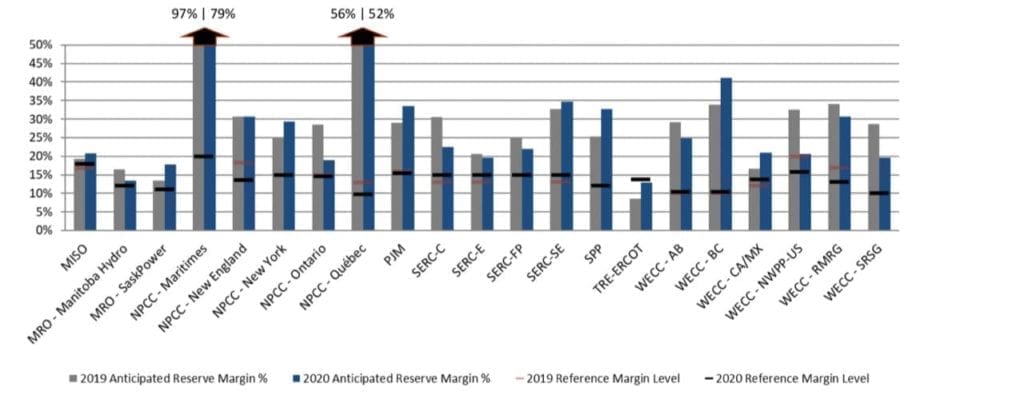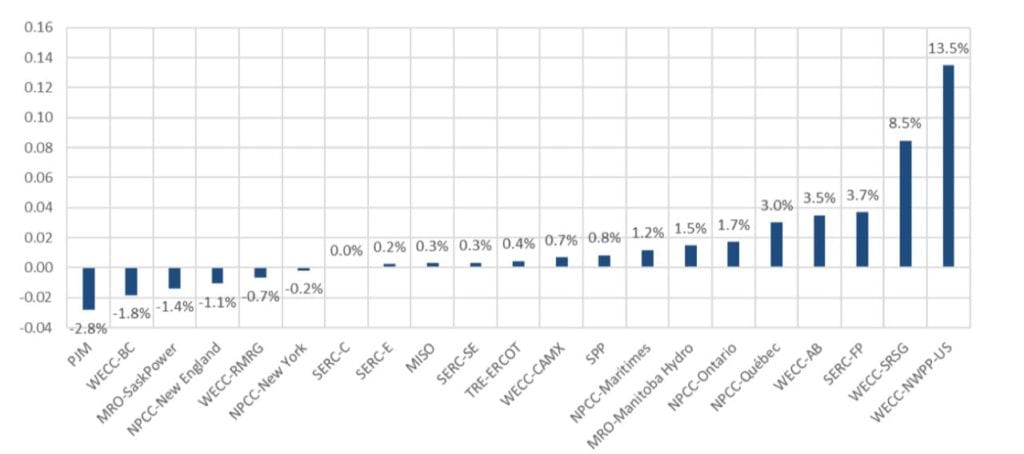NERC: Summer 2020 Reliability Rife With Unknowns
The post NERC: Summer 2020 Reliability Rife With Unknowns appeared first on POWER Magazine.

Despite COVID-19's impact on power demand, disrupted pre-season generation preparation, and an expected highly active hurricane and wildfire season, industry appears well-positioned to meet peak demand this summer under anticipated weather in nearly all parts of the North American bulk power system (BPS).
Other than in the Electric Reliability Council of Texas (ERCOT), anticipated reserve margins in all BPS regions meet or exceed their reference margin level for this summer, even though they are based on pre-pandemic demand forecasts and anticipated resources, the North American Electric Reliability Corp. (NERC) says in its June 2-released 2020 Summer Reliability Assessment (SRA).
As pandemic-related restrictions continue through the summer, we may see electricity peak demand lower than forecast, which could help offset potential challenges with unexpected generation outages or extreme weather impacts," explained John Moura, NERC director of Reliability Assessment and Performance Analysis.
 Summer 2019 to Summer 2020 Anticipated Reserve Margins Year-to-Year Change. Courtesy: NERCUncertainties About Demand a Problem
Summer 2019 to Summer 2020 Anticipated Reserve Margins Year-to-Year Change. Courtesy: NERCUncertainties About Demand a ProblemBut concerns about system reliability this summer have been rife owing to uncertainty in demand projections stemming from the progression of the pandemic, and responses by governments, society, and power sector. Several regions reported drastic demand reductions in response to lockdown measures in April and through May. While NERC said impact projections for summer are difficult to forecast, the assessment indicates that demand projections for most regions will likely be higher than would be expected with pandemic mitigation completely factored in. Should pandemic related restrictions continue through the summer, peak demand is expected to be lower than forecast," NERC noted.
The exception is ERCOT, which said in May it expects tight grid conditions and may set new peak demand records this summer. Factoring in changes to its generation profile, extreme weather, and low wind output, the Texas grid operator also warned it expects energy alerts are still possible.
 Change in Net Internal Demand: 2020 Summer Forecast Compared to 2019 Summer Forecast. Courtesy: NERC
Change in Net Internal Demand: 2020 Summer Forecast Compared to 2019 Summer Forecast. Courtesy: NERCTo deal with changing load shapes, many system operators have instituted measures to improve forecast accuracy, NERC said. However, it urged the sector to remain on guard this summer, noting that system operators could encounter difficult system characteristics," such as an increased impact of distributed energy resources (DERs) on load profiles, distribution reverse power flows, higher than usual operating voltages, and minimum demands at all-time lows.
The effects of DERs on system performance, it explained, can become more pronounced as synchronous generation can be replaced on the system during periods of lower minimum demand. Operators could face challenges in maintaining sufficient amounts of frequency-responsive reserves necessary to regulate or arrest changes in frequency," it said. Operating challenges such as these must be addressed in real-time and often by using complex tools for studying dynamic system conditions," NERC said.
Workforce Constraints Have Affected Generation MaintenanceCompounding the broad uncertainty in demand, industry has also flagged that extensive pre-season preparation efforts by power plants and transmission owners-such as preventative maintenance, supply stocking, and training programs-have been impinged by the global pandemic.
Owing to workforce constraints and safety concerns, many generators have deferred or canceled pre-summer maintenance. Monitoring the progress of ongoing efforts to prepare staff and equipment for summer will be important to ensuring the availability of anticipated resources to meet electricity demand," NERC cautioned. Furthermore, system operators must be prepared to address demand forecast uncertainty and potentially challenging operating conditions as a result of low demand on the system."
The power sector has banded together under the CEO-led Electricity Subsector Coordinating Council (ESCC) to address pandemic-related gaps and ensure the safety of its workforce, as well as to ensure reliability and resilience during the pandemic. The ESCC, which routinely provides updates to a resource guide that it introduced in March, says that system and generation plant operators have implemented operating postures and personnel restrictions prescribed by their pandemic plans in order to protect essential personnel and support reliable operations.
According to NERC's summer assessment, however, many of these measures will need to be maintained for the foreseeable future." NERC underscored that there is a continuing risk that control centers or plants could be temporarily shut down if a significant number of operators or plant employees test positive for COVID-19 despite preparedness efforts. When relaxations can be implemented, operators will likely need to stay postured to return to heightened protections in response to dynamic public health conditions," it said.
NERC, specifically, also highlighted potential equipment and fuel supply chain disruptions related to the pandemic this summer. Natural-gas-fired generators can be at risk to fuel supply infrastructure disruption from mechanical or other issues; planners and operators in areas with impacted preseason maintenance are implementing measures to mitigate such risks. For example, in ISO-NE, the Electric/Gas Operations Committee has been conducting weekly meetings to determine and assess pandemic impacts to pipelines. The ISO has also increased surveying of generator owners and operators to assess outage risks," it noted.
Beyond these challenges, because it is partly reliant on remote working arrangements, industry is also grappling with intensified cybersecurity threats, NERC said. Opportunistic actors are attempting to find and exploit new vulnerabilities that arise as entities shift work processes and locations to maintain business continuity," NERC warned. But here, too, industry is collaborating.
The Electricity Infrastructure Sharing and Analysis Center (E-ISAC) continues to exchange information with its members and has posted communications and guidance from the ESCC and from government partners, and other advisories on its Portal; members are encouraged to check in regularly to receive updates," NERC noted. The E-ISAC is also providing updates about emerging cyberthreats, including attacks on conferencing and remote access infrastructure, disinformation, and spear phishing campaigns attempting to harvest credentials and other information.
Active Season for Storms and WildfiresIn a call with media on May 28, two industry participants who led the development of the ESCC's COVID-19 resource guide-Scott Aaronson, vice president of Security and Preparedness at the Edison Electric Institute (EEI), and Stan Connally, executive vice president of Operations at Southern Co. Services-pointed to new challenges the sector could face as it enters what has been forecast to be an active summer season.
The National Weather Service on May 21 said it expects an above-normal 2020 Atlantic hurricane season, forecasting 13 to 19 named storms-six to 10 which could become hurricanes-are likely starting on June 1 and ending Nov. 30. Government agencies, meanwhile, warn of potential for above-normal wildfire risk beginning as early as June in parts of the Western U.S., as well as Central and Western Canada.
As Aaronson noted, the prospect of weather-related emergency events and potential disasters is especially grave because industry is already operating with a significantly smaller workforce, an encumbered supply chain, limited support services, and financial challenges-and though the ESCC recently put out return-to-work guidance, when the sector will find relief is unknown.
But the ESCC has been exploring all those challenges, including healthcare supplies, as well as issues that could arise over the horizon," he said, and the effort has benefitted immensely from industry collaboration. We operate as one big machine, the energy grid of North America. And because of that common cause, we have to work collaboratively to keep this system operational." Driving that collaborations, he noted, is that the industry is rooted in continuity and contingency planning, because we don't have the luxury of not being operational. The services that we provide to our customers and our communities are critical to their life and safety to the health of our economy and to the health of our nation."
Connally said that the ESCC is spearheading storm response and recovery efforts by assessing existing plans for pandemics and natural disasters, and that its key response will be effective mutual assistance rendered by organizations from the storm-affected areas. In April, the ESCC updated its resource guide to provide lessons learned from the experience of the utilities, electric cooperatives, and investor-owned electric companies affected by a series of storms in late March and early April of this year, he said. Among lessons learned are considerations for maintaining social distancing at all times, planning for personnel protection equipment needs, and increased need for local logistical and coordination personnel to support a decentralized response.
Meanwhile, while mutual assistance has traditionally been deployed to help restore electric service to customers, typically focused on T&D infrastructure, the ESCC's resource guide notes that the COVID-19 pandemic has motivated generation entities to consider the use of mutual assistance for generation plant operation." The guide notes key challenges as they relate to generation-related mutual aid, such as for task variance, knowledge of operational practice, system customization, and legal indemnification.
But as Aaronson told POWER last week, the ESCC's efforts to uniquely consider generation mutual assistance was rooted in an abundance of caution," and it involved looking over the horizon at potential responses that we might have to execute, so we're not caught flat-footed and making it up as we go along so early on in the pandemic."
The ESCC observed that some of our most highly skilled and hardest-to-replace workforce" are in control centers and generating facilities. And so, there have been some pretty extraordinary measures to keep those people healthy, whether it's going to staggered shifts, whether it's decentralizing some of that work and going to the backup facilities, whether it's sequestering," he said. We wanted to be thinking about the potential for sharing employees between and among companies in case we had a particular company that was hard hit or lost a significant portion of its workforce and needed some backup support."
So far, however, we have not come to that point yet-and hopefully we never will," he said.
-Sonal Patel is a POWER senior associate editor (@sonalcpatel, @POWERmagazine).
The post NERC: Summer 2020 Reliability Rife With Unknowns appeared first on POWER Magazine.